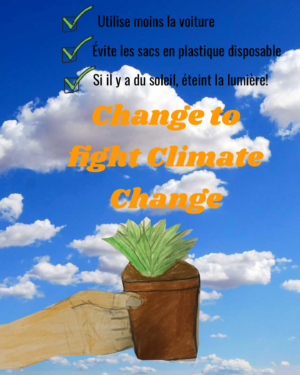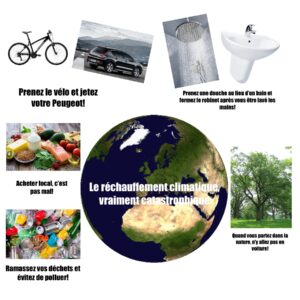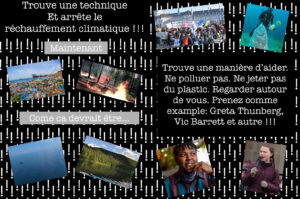Last year, human behaviors and habits abruptly changed: we stopped commuting to work, we logged on to our computers to go to school, we stopped “going out”… and planet earth got a breather. A moment when the constant generation of CO2 emissions took a break. We didn’t do it on purpose, but along came an awareness that mother nature was benefiting from our reduced commutes, international trips, and overall declining consumption of all kinds of necessary and unnecessary goods. What if our behaviors, the ones that reduce humans’ impact on the planet, became intentional?

Throughout the month of March, students in grades 9 to 12 explored ways to make their lives – and ours – greener with a High School Climate Convention organized by the Cultural Center. They delved into the ecological impacts of rare earth extractions, the steps to consider behind zero waste, the technologies that can help curtail our energy consumption. They calculated CO2 emissions depending on the method of transportation and researched companies that provide eco-friendly solutions. Overall, they took a look at their own behaviors, at home, at school, and in the streets of New York.
Of course, the Lycée had already started its journey towards sustainability several years ago, becoming a member of the Green Schools Alliance and participating in several initiatives you may already know. In the unique New York City landscape of concrete, asphalt, honking cars and plastic bags blowing in the trees, the Lycée created an ecosystem that is more environmentally friendly : students don’t think twice when they are asked to compost organic waste, in the spring and summer, vegetables from the primary school’s garden bring colors to the outdoor patio and a wind turbine produces energy each day to help light up the school’s classrooms… Ennead Architects, who designed the Lycée’s buildings on 75th street, also took a close look into how light travels in winter and summer to optimize our natural light as well as regulate heat.

But the journey to net zero greenhouse gas emissions – as New York City and France have pledged to reach by 2050 – is still abounding with obstacles and challenges. Thanks to a wind turbine and solar panels, the Lycée produces 2% of the electricity it needs to operate; could we do better?
As Nathalie Villermet, an expert on Waste Management at the Crépan, a French organization dedicated to protecting nature and the environment who helped students find solutions to reduce waste, says, “We cannot wait for others to take action. Each one of us – whether you are part of a business, whether you are a politician or a consumer – must act and do everything possible to make change happen.”
Aided by their teachers and five experts in different fields as well as the participation of Terrence Kennedy, Director of Facilities at the Lycée, the students came up with concrete solutions to reduce our carbon footprint. Just like the Convention Citoyenne pour le Climat held in France in 2019, which yielded 149 proposals leading to the “Loi climat et résilience”, the Convention Lycéenne pour le Climat brought to light 74 proposals for change, 34 of which are specific to the Lycée.

The students worked within five different themes: consumption, transportation, housing, producing, food. On March 31st, they delivered proposals to go further than what is already being done. Their proposals are as imaginative as they are concrete: opening a Lycée pop-up store for vintage clothing, using apps to determine the environmental footprint of food, organizing friendly “number of steps” competitions.
Two experts on the topic were present to provide feedback to students: Sébastien Treyer, Executive Director of l’IDDRI, a French think-tank that facilitates the transition to sustainable development (who held a conference on the subject early March), and Vincent Colomb, Engineer for the ADEME, the French agency dedicated to sustainable development. They invited students to think broadly about the impact their proposals may have if implemented and invited them to make the best of resources that may already be available.

Our Head of School, Evelyne Estey, members of the Association des Parents d’Élèves, along with the Conseil des Élèves and Student Environmental Taskforce have agreed to review the proposals and choose at least one that can materialize. Keep an eye out to hear which ideas will come to life, most likely starting the next school year.
As Stephan Knust, Senior Associate Director of Sustainability at Ennead Architects tells students regarding changing our behaviors in favor of eco-responsible ones: “This should be seen as an opportunity to do all of the things you love to do. Doing it within the context of a larger purpose – that’s a unifying feeling. (…) As long as a person is mindful about what they are choosing, everyone can do something small and do their part.”
With Earth Day just around the corner on April 22, maybe you too will take a moment to reflect, learn and think “What part should I play for the planet?”.
About the Author :
Charlotte Hartwell obtained a Master’s degree in Culture and Communication from Paris 8 University (France) in 2015 and has since dedicated her career to providing educational and arts-related experiences to people of all ages, including at MoMA, the San Diego Museum of Art and Sunny Side of the Doc. She joined the Lycée’s Cultural Center in 2019 and is glad to be continuing in this direction for students. A dual citizen of France and the United States, Charlotte is familiar with bilingual education, having herself pursued an OIB baccalauréat at the Lycée Georges Duby near Aix-en-Provence, France.

